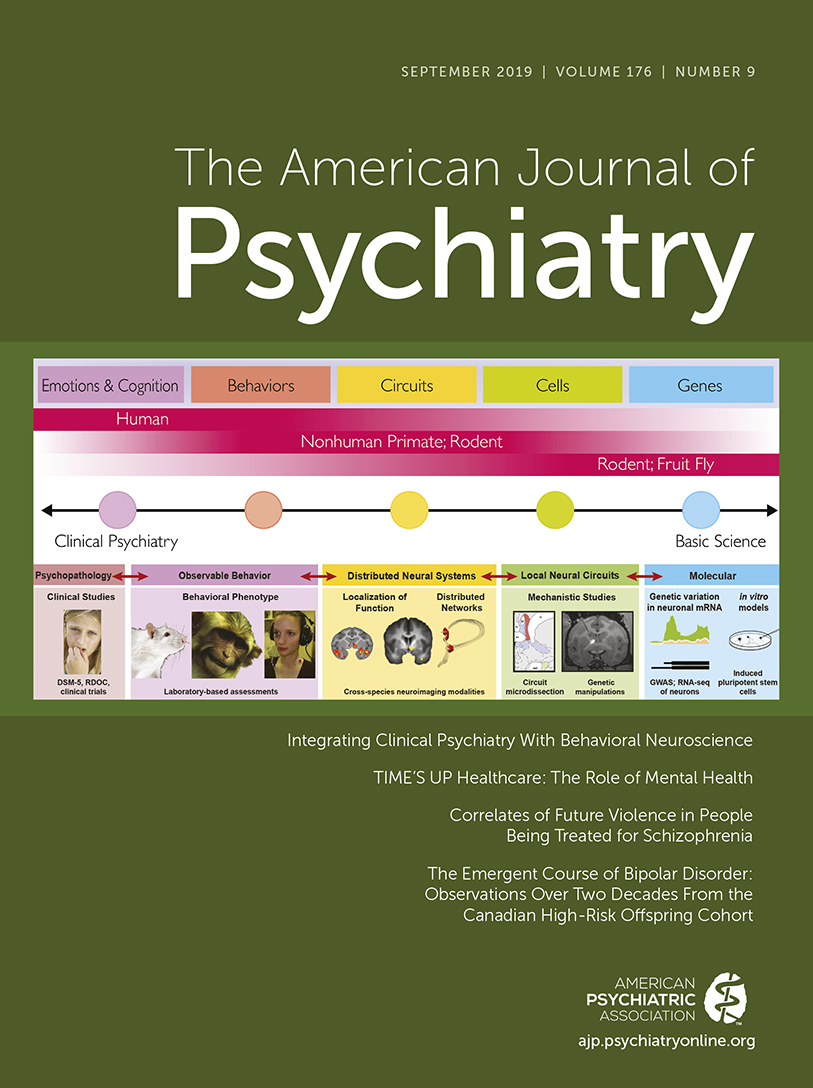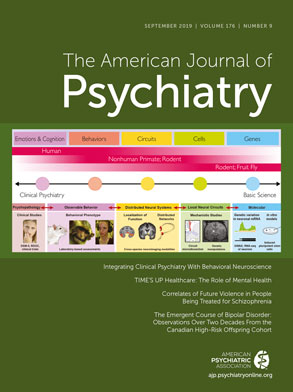As I sit here midsummer, 6 months after officially beginning my term as Editor-in-Chief of the
American Journal of Psychiatry, I am taking the opportunity to reflect, to reiterate my vision (
1), and to thank those who have already contributed in very meaningful ways to our early success. As the official journal of APA, the
American Journal of Psychiatry is the voice of psychiatry not only in the United States but also worldwide. The
Journal’s publications are of the highest quality, and its reach is enormous, with near universal presence in medical libraries and research institutions and an impact factor of 13.655 (which surpasses 98.7% of the 12,515 journals indexed for impact factor calculations). In the last year,
Journal articles were accessed or downloaded more than 3.2 million times, providing evidence of the high level of relevance and interest in the articles published and the potential influence the
Journal can have on the field. Throughout the
Journal’s 175-year history, one of only a few journals with this extraordinary longevity, it has documented the dramatic changes and advances in our field and has served to improve the care of our patients by bringing the latest clinical and scientific advances to psychiatrists, psychologists, and other mental health care providers.
There is no question that the
Journal is one of the premier journals in psychiatry. In addition to its role in educating practitioners and scientists, I view the
Journal as a vehicle to inform the lay public about new advances and as a medium to stimulate changes that will result in more rapid improvements in the care of those suffering from mental illnesses. A current example of how the
Journal can be used to directly address important ethical issues and promote change is featured in this September issue with the publication of the commentary “TIME’S UP Healthcare: The Role of Mental Health” by Jessica Gold and colleagues (
2). This bellwether commentary speaks to sexual harassment and gender discrimination in the health care workplace and puts forth a call to psychiatrists and other mental health workers to take a leadership role in helping to remedy these inequities.
The Journal’s scope is broad, as it is essential that it reflects the breadth and multifaceted nature of our field. The Journal’s mission is to publish the very best research and commentaries focused on improving clinical care as well as the science that underlies these clinical advances. The Journal has excelled in the clinical arena, publishing the latest relevant clinical trials, case series, and clinical case conferences. However, it has lagged behind when it comes to publishing articles pertaining to the more basic scientific advances that address the mechanisms and underpinnings of psychopathology and the neuroscientific rationales for the development of more effective treatments. These articles are important to our readership, as they shed light on the fundamentals that underlie innovative imaging, genetic, molecular, analytic, and preclinical strategies that will result in major improvements to our understanding of mental illnesses. The findings from these articles will ultimately lead to better treatments. My intent is to build on the excellence of the Journal by augmenting its clinical emphasis with clinically relevant basic and translational neuroscientific reports. And be it through commentaries, podcasts, social media, videos, or some combination of these, I am committed to presenting these articles in a way that is engaging and accessible to our audience.
In beginning to facilitate this vision, one of the changes that I have made to the
Journal has been to thematically organize many of the issues. Although the current issue is composed of a variety of topics (allowing me the opportunity to write this reflection), thematic organization provides a platform for focused, in-depth, up-to-date presentation of findings and thoughtful discussion relevant to the topic at hand. It allows for the integration of clinically oriented articles with more basic behavioral neuroscience articles that can inform clinical findings. So far, the themes of this year's issues have been diverse and reflective of the wide range of topics that our field encompasses. These themes have included psychiatric genetics, substance use disorders, childhood and adolescent psychopathology, psychosocial and psychotherapy interventions, depression, novel therapeutics, and neuroimaging methods. In addition to the topically organized original research articles, for many issues I have invited a leading expert to write a brief and accessible overview of the issue’s theme with the aim of providing our readers with a fundamental understanding of the concepts, methods, analytic strategies, and future directions that are relevant to the topic. In this regard, it has been a pleasure to work with and to benefit from the insightful contributions of Danny Weinberger (
3), Francis Lee (
4), Alan Schatzberg (
5), Josh Gordon (
6), Amit Etkin (
7), and Jordan Smoller (
8). I am also very grateful to our invited commentators who, on relatively short notice, have written perceptive pieces addressing matters raised by key articles in each issue. The added value of this comprehensive and focused approach is that each issue will provide a background of fundamental concepts pertaining to the topic and will set the stage for understanding the new findings that are presented in the context of other work, as well as their implications for the future. By bringing these components together in a systematic way and integrating clinical psychiatry with translational neuroscience, it is my hope that each issue of the
Journal will become a resource that can be used as a teaching tool for a clinically important area.
Ultimately, it is the quality, relevance, and timeliness of the content that makes the Journal an outstanding journal. I want to emphasize the advantage the Journal brings to authors by having their work showcased in a premier journal. I also want to emphasize to our more basic neuroscience colleagues our interest in having the opportunity to present your clinically relevant behavioral neuroscience findings to a large worldwide readership. By bringing together the best translational neuroscience articles with the best clinical articles, the Journal will be unparalleled in its ability to provide a lively forum for the creative sharing of data and ideas. Overall, we are looking for papers that present findings with the potential to open up new areas of research or that will fundamentally change the way we practice. These contributions will help the Journal in its mission to serve the field and, importantly, will contribute to our ultimate goal of improving the lives of our suffering patients.

